17 June, 2000
Mummies and Kayaks
We sailed into port at Nuuk, Greenland on Friday around 3 P.M. Today,
Saturday, I made a trip to the Greenland National Museum and Archives. The
museum is small, but fascinating. Two exhibits in parcticular caught my
attention. I thought that you as well might be interested in the exhibits.
The most exciting exhibit is the "Mummies of Qilakitsoq." Qilakitsoq, is
near Uummannaq, which is roughly 600 miles north of Nuuk. Hans and Jokum
Gronvold of Uummannaq were out hunting Ptarmigan in 1972 when they stumbled
upon a cave that held the mummified remains of six adult women, ranging in
age from 20 to 50, and two children, a six-month-old infant and a
four-year-old boy. With much secrecy, they were not exhumed until 1978. The
bodies had been well preserved, basically freeze-dried, due to the natural
drainage, the dry air and low temperature of the cave. Carbon-14 dating has
indicated that the bodies are from the mid- to late 1400's. The reason for
the bodies to have been placed in the cave is unknown, although some believe
that they were seen a burdens, due to illness, and sent away to fend for
themselves. Through scientific studies utilizing x-rays and other means,
it is known that one of the children may have had Down's syndrome and all of
the adults had tumors located on their bones. Close inspection of the skin
revealed five of the women had tattoos, something that was common for the
Inuit, especially women.
Before the mummies had been found, little was known about the dress of
Inuit women in the 15th century. The bodies were found with heavy clothing.
Since the exhumation, the clothes have been recreated using measurements
taken from the originals. The clothing makes great use of seal, caribou,
polar bear, and bird skins. One of the coats in the exhibit is composed of
feathers from five different species of bird. Also found in the cave were
amulets. Amulets were meant to invigorate the owner and protect him/her
from evil spirits. The bodies have added to an understanding of Inuit
women, their relationships, an diseases of that time. Of course like most
discoveries, the knowledge gained is outweighed by the questions that arise.
The other exhibit I enjoyed was one that would be of great interest back
home in Nome.
For hunting, the Inuit developed the Kayak, also known as qajaq or umiaq.
Traditional kayaks are built from driftwood. The wooden frame is covered
with sealskin and waterproofed with animal fat. The design of the boats was
long and narrow to allow the passenger right him or herself when the boat
rolled over. Women and children's boat differed slightly in design.
These boats were used largely for transporting other people or cargo. To
see the construction of these boats is a sight to behold. The quality and
craftsmanship is unparalleled.
Sunday morning we set sail to head north to the ice once again. Plans as of
this moment have us heading to Disko Bay, around 70 degrees North latitude
on the west coast of Greenland. Wherever we head, I am sure that there will
be exciting things to see, learn and do.
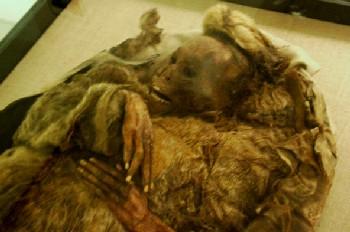
Mummafied remains of Inuit fifty-year-old female from the 15th century.
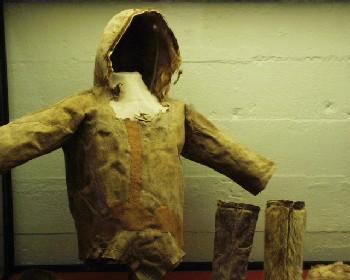
Inuit coat of the 15th century. (3)
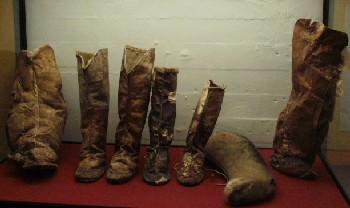
Inuit boots of the 15th century. (5)
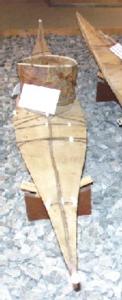
A child's qajaq. (9)
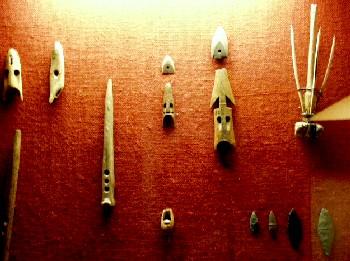
Artifacts found at the grave site.

Inuit woman's boat, also known as a umiaq. (7)
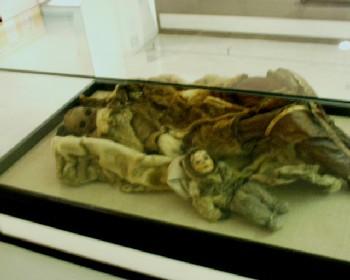
Mummafied remains of adult and six-month-old child (2)

An Inuit coat of the 15th century, made from five types of bird feathers. (7?)
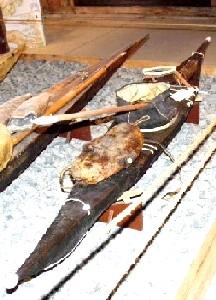
An Inuit boy's qajaq from 1898, recently restored. (9)
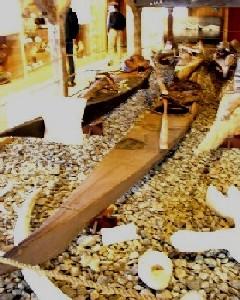
An Inuit male's qajaq.(10)

Typical rock formations on the southwest coast of Greenland.
Contact the TEA in the field at
.
If you cannot connect through your browser, copy the
TEA's e-mail address in the "To:" line of
your favorite e-mail package.
|
